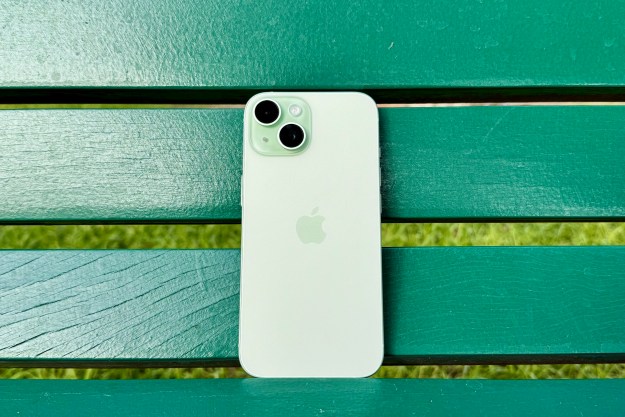
OnePlus has officially entered the foldable phone fray, going up against the likes of Samsung. In fact, OnePlus appears to have done a surprisingly impressive job in its very first attempt, blending refined hardware with a finely tuned software experience. OnePlus’ folding phone is called the OnePlus Open, and it’s a prime competitor of the Samsung Galaxy Z Fold 5.
- OnePlus Open vs. Samsung Galaxy Z Fold 5: specs
- OnePlus Open vs. Samsung Galaxy Z Fold 5: design and hardware
- OnePlus Open vs. Samsung Galaxy Z Fold 5: screens
- OnePlus Open vs. Samsung Galaxy Z Fold 5: cameras
- OnePlus Open vs. Samsung Galaxy Z Fold 5: internals
- OnePlus Open vs. Samsung Galaxy Z Fold 5: software
- OnePlus Open vs. Samsung Galaxy Z Fold 5: verdict
OnePlus put ambitious camera hardware inside the OnePlus Open that puts it on par with dedicated camera-centric flagships. It also builds on the company’s lead in battery charging technology, especially when pitted against the top-tier phones from top brands like Apple, Samsung, and Google. Is it a proper Galaxy Z Fold 5 killer? Read on to find out.
OnePlus Open vs. Samsung Galaxy Z Fold 5: specs
| OnePlus Open | Samsung Galaxy Z Fold 5 | |
|---|---|---|
| Size | 153.4 x 143.1 x 5.8 mm | Unfolded: 6.11 x 5.12 x 0.25 inches
Folded: 6.11 x 2.64 x 0.62 inches |
| Weight | 239 grams | 263 grams |
| Screen | Main: 7.82-inch inner Flexi-fluid AMOLED
Cover: 6.31-inch inner Super Fluid AMOLED |
Main: 7.6-inch Dynamic AMOLED 2X
Cover: 6.2-inch Dynamic AMOLED 2X |
| Screen resolution | Main: 2440 x 2268 pixels (426 pixels per inch)
Cover: 2484 x 1116 pixels (431 pixels per inch) |
Main: 2176 x 1812 pixels (372 pixels per inch)
Cover: 2316 x 904 pixels (402 pixels per inch) |
| Operating system | Android 13 with OxygenOS 13.2 | |
| Storage | 512GB | 256GB, 512GB, 1TB |
| MicroSD card slot | No | No |
| Tap-to-pay services | Google Pay | Google Pay, Samsung Pay |
| Processor | Qualcomm Snapdragon 8 Gen 2 | Qualcomm Snapdragon 8 Gen 2 |
| Camera | Rear: 48-megapixel primary + 48-megapixel ultrawide + 64-megapixel telephoto
Front: 32-megapixel (cover display) and 20-megapixel (inner display) |
Rear: 50-megapixel (MP) primary, 12MP ultrawide, and 10MP telephoto
Front: 4MP under-display on main screen and 10MP on cover screen: |
| Video | 1080p at 30/60 fps at 30/60 fps Slo-mo video at 1080p, 240/480 fps; |
8K at 24 frames per second
1080p FHD at 30/60 fps 720p HD at 30 fps Super Slow-mo 720p at 960 fps Slow motion 1080p at 240 fps |
| Connectivity | 2×2 MIMO 2.4G/ Wi-Fi 6E, Wi-Fi 7 Wi-Fi 802.11 a/b/g/n/ac/ac wave 2/ax/be, 8 Spatial-stream sounding MU-MIMO |
2G GSM, 3G WCDMA, 4G LTE FDD, 4G LTE TDD, |
| Bluetooth version | Bluetooth 5.3 | Bluetooth 5.3 |
| Ports | USB-C | USB-C |
| Water resistance | IPX4 | IPX8 |
| Battery | 4,805 mAh 67W SUPERVOOC wired Charging |
4,400 mAh 25 W fast charging Wireless charging and reverse wireless charging |
| App marketplace | Google Play Store | Google Play Store |
| Colors | Emerald Dusk, Voyager Black | Graygreen, Phantom Black, beige, burgundy (Samsung Exclusive) |
| Price | Starts at $1,699 | Starts at $1,800 |
OnePlus Open vs. Samsung Galaxy Z Fold 5 : design and hardware

One of the biggest design flaws that Samsung addressed with its current-generation foldable is the display wedge, which has been removed. All previous Samsung foldables have had an open gap when the two halves are shut. This space was an open invitation to dirt, liquid, and other undesirable elements. The Z Fold 5 closes completely flat when it’s shut and doesn’t have this problem.
Samsung made progress this time around by paying special attention to the inner foldable screen and the hinge durability. The

OnePlus has managed to solve that part of the problematic equation with a gapless design in its first attempt. When the phone is closed, there is no gap left across any edge. Both the phones rely on a metal and glass foundation, but OnePlus once again went for a more exquisite concoction. Where Samsung uses stainless steel and Gorilla Glass Victus, the
Coming to the display engineering, the foundation is identical — a flexible Ultra-Thin Glass (UTG) layer. But that’s where the similarities end. Where Samsung adopts Corning’s Gorilla Glass Victus, the
Even in the aesthetics department, OnePlus has taken an edge over its Samsung rival. The
Winner:
OnePlus Open vs. Samsung Galaxy Z Fold 5: screens
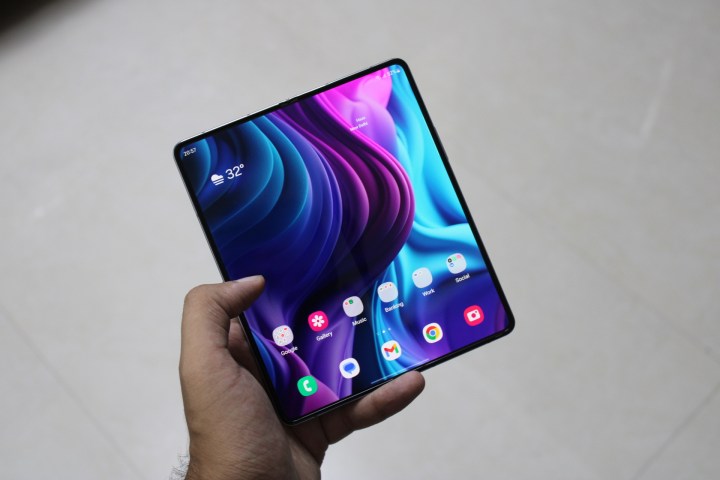
One of the biggest trade-offs that Samsung made in its quest to make foldable phones more comfortable was making them tall so that one-handed usage is not much of a chore. But in doing so, the company went with a tall aspect ratio for the cover display that really takes its own toll on the user experience because of odd app scaling due of tight horizontal space. On the
Otherwise, both the panels are as good as one gets on a phone. On the
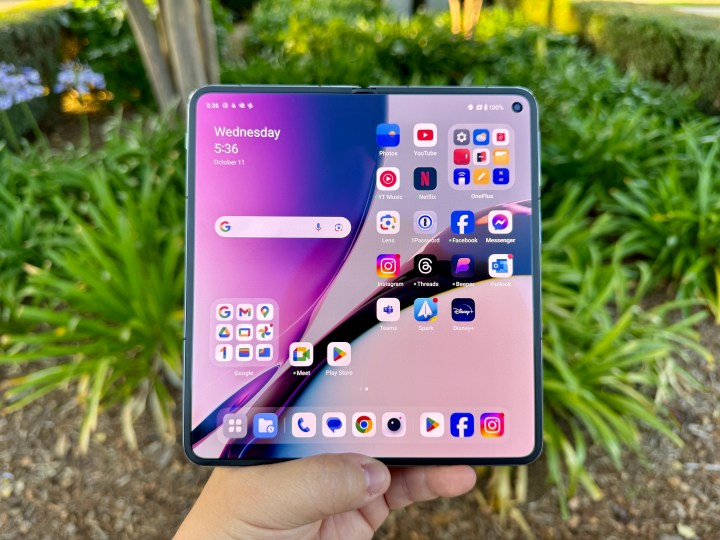
Both OnePlus and Samsung have baked in their own system-level tweaks for app window management. But the
It’s hard to pick a winner here in terms of sheer quality, as both phones offer screens with a vivid color profile, adequate brightness output, and freaky viewing angles. But if one were to nitpick, the inner foldable screen on the Galaxy Z Fold seems more immersive, and that’s because of the under-display camera tech that virtually hides the round selfie camera and offers an all-screen experience. We’re still going to call it a tie, though.
Winner: Tie
OnePlus Open vs. Samsung Galaxy Z Fold 5: cameras

If one were to do a spec assessment, the OnePlus Open’s camera hardware is leaps and bounds ahead of the
The telephoto camera is the most interesting element here. Despite the phone’s impressively thin profile, OnePlus managed to cram in a massive 64MP periscope-style telephoto camera that offers an optical zoom range of 3x, in-sensor 6x zoom output, and up to 120x Ultra Res digital zoom coverage. The cover screen hosts a 20-megapixel selfie camera, while the inner foldable panel is home to a 32MP sensor.
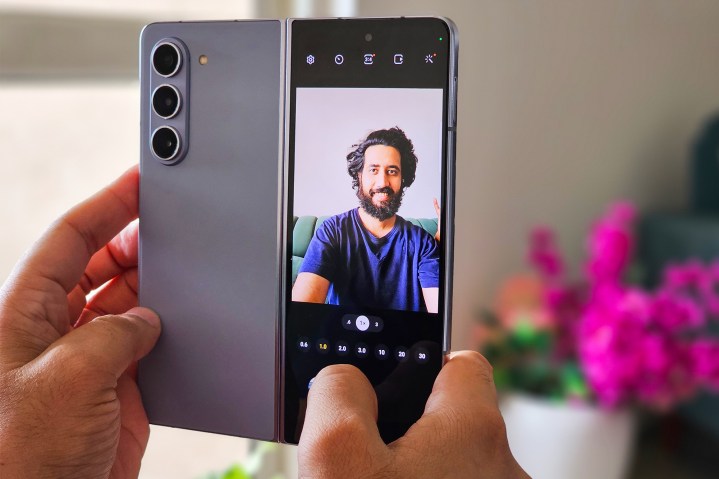
On the
To handle selfies, Samsung’s foldable offers a 10MP camera on the front and a 4MP under-display camera sandwiched between the foldable panel halves. But in the latter’s case, innovation comes at a cost. Since the camera is covered by a layer of pixels, the final image turns out noticeably softer, with lost details and a lot of software-side reconstruction done to it.
Winner:
OnePlus Open vs. Samsung Galaxy Z Fold 5: internals

Samsung’s foldable flagship relies on Qualcomm’s 8 Gen 2 chip, paired with 12GB
OnePlus takes a massive lead when it comes to the power segment. The Chinese brand’s foldable phone features a bigger 4,805 mAh battery. It offers support for 67-watt fast charging, with OnePlus claiming that you can charge the phone from empty to 100% juice in 42 minutes. There is no support for wireless charging here.
On the Samsung
Winner: Samsung
OnePlus Open vs. Samsung Galaxy Z Fold 5: software
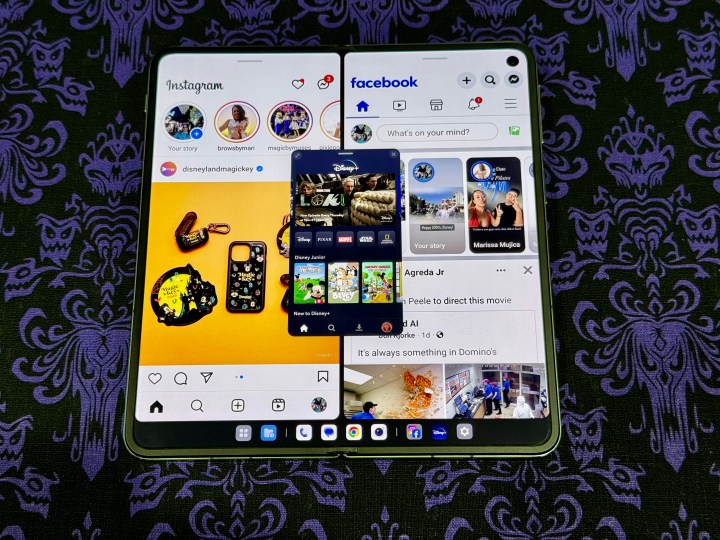
Software can make or break a foldable phone, and at the end of the day, it matters a lot whether you prefer Samsung’s One UI experience or OnePlus’ OxygenOS experience. Both foldable phones offer their own take on split-screen app multitasking, allowing up to three apps to stay active at any given time. Native
OxygenOS has cultivated a fandom of sorts for customizability, but it doesn’t offer the same kind of flexibility in tweaking the UI and behavior of apps that One UI 5.1 (or later versions) does. The Samsung Labs toolkit and the Good Lock modules are the best examples of deep system-level customization that isn’t available on any mainstream phone out there, foldable or otherwise.

The biggest advantage that the
What works in OxygenOS is an active community, and compared to One UI, OnePlus has been quicker at ironing out software quirks owing to that. Both the phones come with an assurance of four years worth of software updates. It isn’t as good as iPhones or the seven-year update promise Google made for the Pixel 8 and Pixel 8 Pro, but four years is still one of the best guarantees that
Winner: Samsung
OnePlus Open vs. Samsung Galaxy Z Fold 5: verdict

There’s only $100 worth of difference between the $1,699
Another aspect that you need to keep in mind is the fact that Samsung has a far deeper presence in the U.S. market compared to OnePlus, so if you run into repair and part replacement situations, getting it done on a Samsung foldable would be a more convenient experience compared to OnePlus. Finally, that IPX8 certification tilts the longevity scale in favor of that
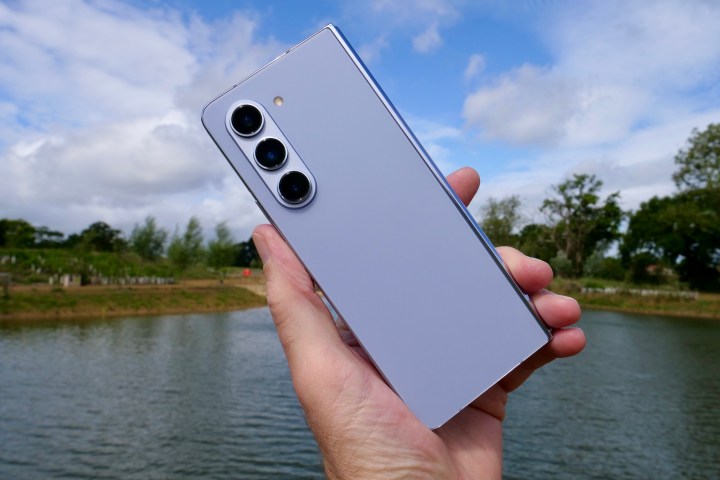
Digital Trends has reached out to OnePlus regarding the brand’s repair and replacement policy for the
If you seek the best camera experience and a standout design that feels as close to a normal phone experience, the
Editors' Recommendations
- The best Samsung Galaxy Watch in 2024: Which one should you buy?
- The Galaxy Z Fold 6 and Flip 6 release date just leaked
- The OnePlus 12R is still one of 2024’s best smartphone deals
- OnePlus surprises us with dazzling Android tablet and smartwatch
- Best Samsung Galaxy S22 deals: Save big on unlocked models


